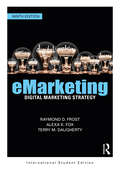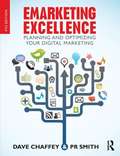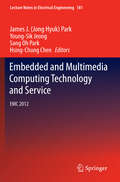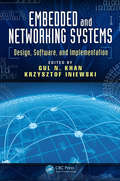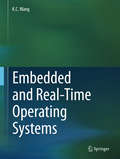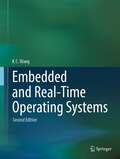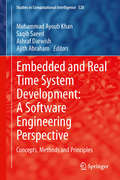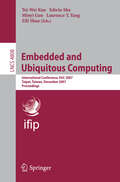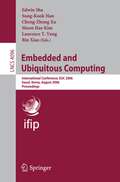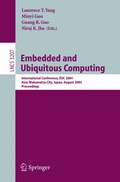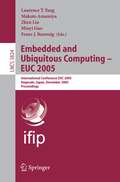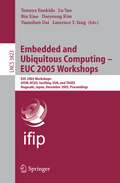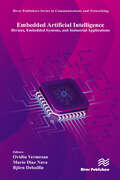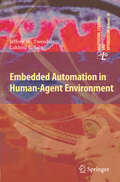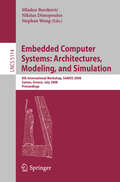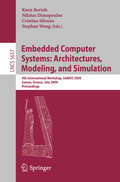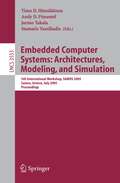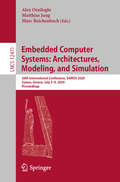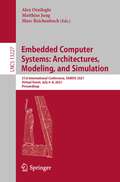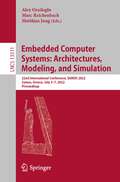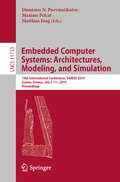- Table View
- List View
Email Marketing: An Hour a Day
by Jeanniey Mullen David DanielsIf the idea of starting an email marketing campaign overwhelms you, the authors of Email Marketing: An Hour a Day will introduce you to email marketing basics, demonstrate how to manage details and describe how you can track and measure results. Case studies, step-by-step guides, checklists, quizzes and hands-on tutorials will help you execute an email marketing campaign in just one hour a day. When you feel comfortable with the basics, learn how to use video and audio enabled email, implement tools like mobile devices and leverage social networks.
eMarketing: Digital Marketing Strategy
by Raymond Frost Alexa K. Fox Terry DaughertyeMarketing, 9th edition, equips students with the solid foundation in digital marketing required to excel in practice and "think like a marketer". The book connects digital marketing topics with the traditional marketing framework, making it easier for students to grasp the concepts and strategies involved in developing a digital marketing plan. With a strategic approach that focuses on performance metrics and monitoring, it is a highly practical book. The 9th edition has been fully updated to include the most cutting-edge trends and topics, including SEO, customer experience, digital media consumption, analytics, big data and AI, and diversity and ethics. Case studies and examples have been updated across the book to demonstrate marketing practice in real organizations globally. Pedagogical features support the theoretical foundation throughout, incorporating "success stories" and "let’s get technical" boxes, as well as activities at the end of each chapter, to aid students in their understanding of, and ability to execute, successful digital marketing strategies. Highly regarded and comprehensive, this textbook is core reading for undergraduate students studying digital marketing and digital business. Online resources include PowerPoint slides and a test bank.
eMarketing: Digital Marketing Strategy
by Raymond Frost Alexa K. Fox Terry DaughertyeMarketing, 9th edition, equips students with the solid foundation in digital marketing required to excel in practice and "think like a marketer". The book connects digital marketing topics with the traditional marketing framework, making it easier for students to grasp the concepts and strategies involved in developing a digital marketing plan. With a strategic approach that focuses on performance metrics and monitoring, it is a highly practical book. The 9th edition has been fully updated to include the most cutting-edge trends and topics, including SEO, customer experience, digital media consumption, analytics, big data and AI, and diversity and ethics. Case studies and examples have been updated across the book to demonstrate marketing practice in real organizations globally. Pedagogical features support the theoretical foundation throughout, incorporating "success stories" and "let’s get technical" boxes, as well as activities at the end of each chapter, to aid students in their understanding of, and ability to execute, successful digital marketing strategies. Highly regarded and comprehensive, this textbook is core reading for undergraduate students studying digital marketing and digital business. Online resources include PowerPoint slides and a test bank.
Emarketing Excellence: Planning And Optimising Your Digital Marketing
by Dave Chaffey P. R. SmithNow in its fourth edition, the hugely successful Emarketing Excellenceis fully updated; keeping you in line with the changes in this dynamic and exciting field and helping you create effective and up-to-date customer-centric e-marketing plans. A practical guide to creating and executing e-marketing plans, it combines established approaches to marketing planning with the creative use of new e-models and e-tools. This new edition seamlessly integrates social media technology like Facebook check-in, social networking, tablets and mobile applications into the mix, demonstrating how these new ways to reach customers can be integrated into your marketing plans. It also includes brand new sections on online marketing legislation and QR codes, plus an expanded section on email marketing, the most commonly used e-marketing tool. Offering a highly structured and accessible guide to a critical and far-reaching subject, Emarketing Excellence 4eprovides a vital reference point for all students of business or marketing and marketers and e-marketers involved in marketing strategy and implementation and who want a thorough yet practical grounding in e-marketing.
Embedded and Multimedia Computing Technology and Service: EMC 2012 (Lecture Notes in Electrical Engineering #181)
by Hsing-Chung Chen James J. Jong Hyuk Park Young-Sik Jeong Sang Oh ParkThe 7th International Conference on Embedded and Multimedia Computing (EMC-12), will be held in Gwangju, Korea on September 6 - 8, 2012. EMC-12 will be the most comprehensive conference focused on the various aspects of advances in Embedded and Multimedia (EM) Computing. EMC-12 will provide an opportunity for academic and industry professionals to discuss the latest issues and progress in the area of EM. In addition, the conference will publish high quality papers which are closely related to the various theories and practical applications in EM. Furthermore, we expect that the conference and its publications will be a trigger for further related research and technology improvements in this important subject. The EMC-12 is the next event, in a series of highly successful International Conference on Embedded and Multimedia Computing, previously held as EMC 2011 (China, Aug. 2011), EMC 2010 (Philippines, Aug. 2010), EM-Com 2009 (Korea, Dec. 2009), UMC-08 (Australia, Oct. 2008), ESO-08(China, Dec. 2008), UMS-08 (Korea, April, 2008), UMS-07(Singapore, Jan. 2007), ESO-07(Taiwan, Dec. 2007), ESO-06(Korea, Aug. 2006).
Embedded and Networking Systems: Design, Software, and Implementation (Devices, Circuits, and Systems #18)
by GUL N. KHAN AND KRZYSZTOF INIEWSKIEmbedded and Networking Systems: Design, Software, and Implementation explores issues related to the design and synthesis of high-performance embedded computer systems and networks. The emphasis is on the fundamental concepts and analytical techniques that are applicable to a range of embedded and networking applications, rather than on specific embedded architectures, software development, or system-level integration. This system point of view guides designers in dealing with the trade-offs to optimize performance, power, cost, and other system-level non-functional requirements. The book brings together contributions by researchers and experts from around the world, offering a global view of the latest research and development in embedded and networking systems. Chapters highlight the evolution and trends in the field and supply a fundamental and analytical understanding of some underlying technologies. Topics include the co-design of embedded systems, code optimization for a variety of applications, power and performance trade-offs, benchmarks for evaluating embedded systems and their components, and mobile sensor network systems. The book also looks at novel applications such as mobile sensor systems and video networks. A comprehensive review of groundbreaking technology and applications, this book is a timely resource for system designers, researchers, and students interested in the possibilities of embedded and networking systems. It gives readers a better understanding of an emerging technology evolution that is helping drive telecommunications into the next decade.
Embedded and Networking Systems: Design, Software, and Implementation (Devices, Circuits, and Systems)
by Gul N. Khan Krzysztof IniewskiEmbedded and Networking Systems: Design, Software, and Implementation explores issues related to the design and synthesis of high-performance embedded computer systems and networks. The emphasis is on the fundamental concepts and analytical techniques that are applicable to a range of embedded and networking applications, rather than on specific embedded architectures, software development, or system-level integration. This system point of view guides designers in dealing with the trade-offs to optimize performance, power, cost, and other system-level non-functional requirements. The book brings together contributions by researchers and experts from around the world, offering a global view of the latest research and development in embedded and networking systems. Chapters highlight the evolution and trends in the field and supply a fundamental and analytical understanding of some underlying technologies. Topics include the co-design of embedded systems, code optimization for a variety of applications, power and performance trade-offs, benchmarks for evaluating embedded systems and their components, and mobile sensor network systems. The book also looks at novel applications such as mobile sensor systems and video networks. A comprehensive review of groundbreaking technology and applications, this book is a timely resource for system designers, researchers, and students interested in the possibilities of embedded and networking systems. It gives readers a better understanding of an emerging technology evolution that is helping drive telecommunications into the next decade.
Embedded and Real-Time Operating Systems
by K. C. WangThis book covers the basic concepts and principles of operating systems, showing how to apply them to the design and implementation of complete operating systems for embedded and real-time systems. It includes all the foundational and background information on ARM architecture, ARM instructions and programming, toolchain for developing programs, virtual machines for software implementation and testing, program execution image, function call conventions, run-time stack usage and link C programs with assembly code.It describes the design and implementation of a complete OS for embedded systems in incremental steps, explaining the design principles and implementation techniques. For Symmetric Multiprocessing (SMP) embedded systems, the author examines the ARM MPcore processors, which include the SCU and GIC for interrupts routing and interprocessor communication and synchronization by Software Generated Interrupts (SGIs).Throughout the book, complete working sample systems demonstrate the design principles and implementation techniques. The content is suitable for advanced-level and graduate students working in software engineering, programming, and systems theory.
Embedded and Real-Time Operating Systems
by K. C. WangThis book covers the basic concepts and principles of operating systems, showing how to apply them to the design and implementation of complete operating systems for embedded and real-time systems. It includes all the foundational and background information on ARM architecture, ARM instructions and programming, toolchain for developing programs, virtual machines for software implementation and testing, program execution image, function call conventions, run-time stack usage and link C programs with assembly code.Embedded and Real-Time Operating Systems describes the design and implementation of a complete OS for embedded systems in incremental steps, explaining the design principles and implementation techniques. For Symmetric Multiprocessing (SMP) embedded systems, the author examines the ARM MPcore processors, which include the SCU and GIC for interrupts routing and interprocessor communication and synchronization by Software Generated Interrupts (SGIs).This Second Edition covers ARM64 architecture and programming. These include exception levels, vector tables and exceptions handling, GICv3 programming and interrupt processing. It covers virtual to physical address mappings in ARMv8, and shows a 64-bit OS with kernel space in EL1 and separate user spaces in EL0. It also covers ARM TrustZone technology and secure systems. These include hardware and software architectures for secure and normal worlds, interactions and switching between the two worlds. It shows a secure world comprising a secure monitor in EL3 to provide service functions, and a normal world comprising processes in non-secure EL1, which use SMC to access service functions in the secure world.Throughout the book, complete working sample systems demonstrate the design principles and implementation techniques. The content is suitable for advanced-level and graduate students working in software engineering, programming, and systems theory.
Embedded and Real Time System Development: Concepts, Methods and Principles (Studies in Computational Intelligence #520)
by Mohammad Ayoub Khan Saqib Saeed Ashraf Darwish Ajith AbrahamNowadays embedded and real-time systems contain complex software. The complexity of embedded systems is increasing, and the amount and variety of software in the embedded products are growing. This creates a big challenge for embedded and real-time software development processes and there is a need to develop separate metrics and benchmarks.“Embedded and Real Time System Development: A Software Engineering Perspective: Concepts, Methods and Principles” presents practical as well as conceptual knowledge of the latest tools, techniques and methodologies of embedded software engineering and real-time systems. Each chapter includes an in-depth investigation regarding the actual or potential role of software engineering tools in the context of the embedded system and real-time system. The book presents state-of-the art and future perspectives with industry experts, researchers, and academicians sharing ideas and experiences including surrounding frontier technologies, breakthroughs, innovative solutions and applications. The book is organized into four parts “Embedded Software Development Process”, “Design Patterns and Development Methodology”, “Modelling Framework” and “Performance Analysis, Power Management and Deployment” with altogether 12 chapters. The book is aiming at (i) undergraduate students and postgraduate students conducting research in the areas of embedded software engineering and real-time systems; (ii) researchers at universities and other institutions working in these fields; and (iii) practitioners in the R&D departments of embedded system. It can be used as an advanced reference for a course taught at the postgraduate level in embedded software engineering and real-time systems.
Embedded and Ubiquitous Computing: IFIP International Conference, EUC 2007, Taipei, Taiwan, December 17-20, 2007, Proceedings (Lecture Notes in Computer Science #4808)
by Tei-Wei Kuo Edwin Sha Minyi Guo Laurence T. Yang Zili ShaoThis book constitutes the refereed proceedings of the International Conference on Embedded and Ubiquitous Computing, EUC 2007, held in Taipei, Taiwan, in December 2007. The 65 revised full papers presented were carefully reviewed and selected from 217 submissions. The papers are organized in topical sections. They include sections on power aware computing, reconfigurable embedded systems, wireless networks, real-time/embedded operating systems, and embedded system architectures.
Embedded and Ubiquitous Computing: International Conference, EUC 2006, Seoul, Korea, August 1-4, 2006, Proceedings (Lecture Notes in Computer Science #4096)
by Edwin Sha Sung-Kook Han Cheng-Zhong Xu Moon Hae Kim Laurence T. Yang Bin XiaoThis book constitutes the refereed proceedings of the International Conference on Embedded and Ubiquitous Computing, EUC 2006, held in Seoul, Korea, August 2006. The book presents 113 revised full papers together with 3 keynote articles, organized in topical sections on power aware computing, security and fault tolerance, agent and distributed computing, wireless communications, real-time systems, embedded systems, multimedia and data management, mobile computing, network protocols, middleware and P2P, and more.
Embedded and Ubiquitous Computing: International Conference EUC 2004, Aizu-Wakamatsu City, Japan, August 25-27, 2004, Proceedings (Lecture Notes in Computer Science #3207)
by Laurence T. Yang Minyi Guo Guang R. Gao Niraj K. JhaWelcome to the proceedings of the 2004 International Conference on Embedded and Ubiquitous Computing (EUC 2004) which was held in Aizu-Wakamatsu City, Japan, 25–27 August 2004. Embedded and ubiquitous computing are emerging rapidly as exciting new paradigms and disciplines to provide computing and communication services all the time, everywhere. Its systems are now invading every aspect of life to the point that they are disappearing inside all sorts of appliances or can be worn unobtrusively as part of clothing and jewelry, etc. This emergence is a natural outcome of research and technological advances in embedded systems, pervasive computing and communications, wireless networks, mobile computing, distri- ted computing and agent technologies, etc. Its explosive impact on academia, industry, government and daily life can be compared to that of electric motors over the past century but promises to revolutionize life much more profoundly than elevators, electric motors or even personal computer evolution ever did. The EUC 2004 conference provided a forum for engineers and scientists in academia, industry, and government to address all the resulting profound ch- lenges including technical, safety, social, legal, political, and economic issues, and to present and discuss their ideas, results, work in progress and experience on all aspects of embedded and ubiquitous computing. There was a very large number of paper submissions (260) from more than 20countriesandregions,includingnotonlyAsiaandthePaci?c,butalsoEurope and North America. All submissions were reviewed by at least three program or technical committee members or external reviewers.
Embedded and Ubiquitous Computing - EUC 2005: International Conference EUC 2005, Nagasaki, Japan, December 6-9, 2005, Proceedings (Lecture Notes in Computer Science #3824)
by Zhen Liu Minyi Guo Franz J. Rammig Laurence T. Yang Makoto AmamiyaWelcome to the proceedings of the 2005 IFIP International Conference on - bedded and Ubiquitous Computing (EUC 2005), which was held in Nagasaki, Japan, December 6–9, 2005. Embedded and ubiquitous computing is emerging rapidly as an exciting new paradigm to provide computing and communication services all the time, - erywhere. Its systems are now pervading every aspect of life to the point that they are hidden inside various appliances or can be worn unobtrusively as part of clothing and jewelry. This emergence is a natural outcome of research and technological advances in embedded systems, pervasive computing and c- munications, wireless networks, mobile computing, distributed computing and agent technologies, etc. Its tremendous impact on academics, industry, gove- ment, and daily life can be compared to that of electric motors over the past century, in fact it but promises to revolutionize life much more profoundly than elevators, electric motors or even personal computers. The EUC 2005 conference provided a forum for engineers and scientists in academia, industry, and government to address profound issues including te- nical challenges, safety, and social, legal, political, and economic issues, and to present and discuss their ideas, results, work in progress, and experience on all aspects of embedded and ubiquitous computing.
Embedded and Ubiquitous Computing - EUC 2005 Workshops: EUC 2005 Workshops: UISW, NCUS, SecUbiq, USN, and TAUES, Nagasaki, Japan, December 8-9, 2005 (Lecture Notes in Computer Science #3823)
by Tomoya Enokido Lu Yan Bin Xiao Daeyoung Kim Yuanshun Dai Laurence T. YangEmbedded Artificial Intelligence: Devices, Embedded Systems, and Industrial Applications
by Ovidiu Vermesan Mario Diaz Nava Bjö DebaillieRecent technological developments in sensors, edge computing, connectivity, and artificial intelligence (AI) technologies have accelerated the integration of data analysis based on embedded AI capabilities into resource-constrained, energy-efficient hardware devices for processing information at the network edge. Embedded AI combines embedded machine learning (ML) and deep learning (DL) based on neural networks (NN) architectures such as convolutional NN (CNN), or spiking neural network (SNN) and algorithms on edge devices and implements edge computing capabilities that enable data processing and analysis without optimised connectivity and integration, allowing users to access data from various sources. Embedded AI efficiently implements edge computing and AI processes on resource-constrained devices to mitigate downtime and service latency, and it successfully merges AI processes as a pivotal component in edge computing and embedded system devices. Embedded AI also enables users to reduce costs, communication, and processing time by assembling data and by supporting user requirements without the need for continuous interaction with physical locations. This book provides an overview of the latest research results and activities in industrial embedded AI technologies and applications, based on close cooperation between three large-scale ECSEL JU projects, AI4DI, ANDANTE, and TEMPO. The book’s content targets researchers, designers, developers, academics, post-graduate students and practitioners seeking recent research on embedded AI. It combines the latest developments in embedded AI, addressing methodologies, tools, and techniques to offer insight into technological trends and their use across different industries.
Embedded Artificial Intelligence: Devices, Embedded Systems, and Industrial Applications
by Ovidiu Vermesan Mario Diaz Nava Björn DebaillieRecent technological developments in sensors, edge computing, connectivity, and artificial intelligence (AI) technologies have accelerated the integration of data analysis based on embedded AI capabilities into resource-constrained, energy-efficient hardware devices for processing information at the network edge. Embedded AI combines embedded machine learning (ML) and deep learning (DL) based on neural networks (NN) architectures such as convolutional NN (CNN), or spiking neural network (SNN) and algorithms on edge devices and implements edge computing capabilities that enable data processing and analysis without optimised connectivity and integration, allowing users to access data from various sources. Embedded AI efficiently implements edge computing and AI processes on resource-constrained devices to mitigate downtime and service latency, and it successfully merges AI processes as a pivotal component in edge computing and embedded system devices. Embedded AI also enables users to reduce costs, communication, and processing time by assembling data and by supporting user requirements without the need for continuous interaction with physical locations. This book provides an overview of the latest research results and activities in industrial embedded AI technologies and applications, based on close cooperation between three large-scale ECSEL JU projects, AI4DI, ANDANTE, and TEMPO. The book’s content targets researchers, designers, developers, academics, post-graduate students and practitioners seeking recent research on embedded AI. It combines the latest developments in embedded AI, addressing methodologies, tools, and techniques to offer insight into technological trends and their use across different industries.
Embedded Automation in Human-Agent Environment (Adaptation, Learning, and Optimization #10)
by Jeff Tweedale Lakhmi C. JainThis research book proposes a general conceptual framework for the development of automation in human-agents environments that will allow human- agent teams to work effectively and efficiently. We examine various schemes to implement artificial intelligence techniques in agents. The text is directed to the scientists, application engineers, professors and students of all disciplines, interested in the agency methodology and applications.
Embedded Computer Systems: 8th International Workshop, SAMOS 2008, Samos, Greece, July 21-24, 2008, Proceedings (Lecture Notes in Computer Science #5114)
by Mladen Berekovic Nikitas Dimopoulos Stephan WongThis book constitutes the refereed proceedings of the 8th International Workshop on Systems, Architectures, Modeling, and Simulation, SAMOS 2008, held in Samos, Greece, in July 2008. The 24 revised full papers presented together with a contamplative keynote and additional papers of two special workshop sessions were carefully reviewed and selected from 62 submissions. The papers are organized in topical sections on architecture, new frontiers, SoC, application specific contributions, system level design for heterogeneous systems, programming multicores, sensors and sensor networks; and systems modeling and design.
Embedded Computer Systems: 9th International Workshop, SAMOS 2009, Samos, Greece, July 20-23, 2009, Proceedings (Lecture Notes in Computer Science #5657)
by Koen Bertels Nikitas Dimopoulos Cristina Silvano Stephan WongEmbedded Computer Systems: 5th International Workshop, SAMOS 2005, Samos, Greece, July 18-20, Proceedings (Lecture Notes in Computer Science #3553)
by Timo D. Hämäläinen Andy D. Pimentel Jarmo Takala Stamatis VassiliadisThe SAMOS workshop is an international gathering of highly quali?ed researchers from academia and industry, sharing in a 3-day lively discussion on the quiet and - spiring northern mountainside of the Mediterranean island of Samos. As a tradition, the workshop features workshop presentations in the morning, while after lunch all kinds of informal discussions and nut-cracking gatherings take place. The workshop is unique in the sense that not only solved research problems are presented and discussed but also (partly) unsolved problems and in-depth topical reviews can be unleashed in the sci- ti?c arena. Consequently, the workshop provides the participants with an environment where collaboration rather than competition is fostered. The earlier workshops, SAMOS I–IV (2001–2004), were composed only of invited presentations. Due to increasing expressions of interest in the workshop, the Program Committee of SAMOS V decided to open the workshop for all submissions. As a result the SAMOS workshop gained an immediate popularity; a total of 114 submitted papers were received for evaluation. The papers came from 24 countries and regions: Austria (1), Belgium (2), Brazil (5), Canada (4), China (12), Cyprus (2), Czech Republic (1), Finland (15), France (6), Germany (8), Greece (5), Hong Kong (2), India (2), Iran (1), Korea (24), The Netherlands (7), Pakistan (1), Poland (2), Spain (2), Sweden (2), T- wan (1), Turkey (2), UK (2), and USA (5). We are grateful to all of the authors who submitted papers to the workshop.
Embedded Computer Systems: 20th International Conference, SAMOS 2020, Samos, Greece, July 5–9, 2020, Proceedings (Lecture Notes in Computer Science #12471)
by Alex Orailoglu Matthias Jung Marc ReichenbachThis book constitutes the refereed proceedings of the 20th International Conference on Embedded Computer Systems: Architectures, Modeling, and Simulation, SAMOS 2020, held in Samos, Greece, in July 2020.*The 16 regular papers presented were carefully reviewed and selected from 35 submissions. In addition, 9 papers from two special sessions were included, which were organized on topics of current interest: innovative architectures for security and European projects on embedded and high performance computing for health applications. * The conference was held virtually due to the COVID-19 pandemic.
Embedded Computer Systems: 21st International Conference, SAMOS 2021, Virtual Event, July 4–8, 2021, Proceedings (Lecture Notes in Computer Science #13227)
by Alex Orailoglu Matthias Jung Marc ReichenbachThis book constitutes the proceedings of the 21st International Conference on Embedded Computer Systems: Architectures, Modeling, and Simulation, SAMOS 2021, which took place in July 2021. Due to COVID-19 pandemic the conference was held virtually. The 17 full papers presented in this volume were carefully reviewed and selected from 45 submissions. The papers are organized in topics as follows: simulation and design space exploration; the 3Cs - Cache, Cluster and Cloud; heterogeneous SoC; novel CPU architectures and applications; dataflow; innovative architectures and tools for security; next generation computing; insights from negative results.
Embedded Computer Systems: 22nd International Conference, SAMOS 2022, Samos, Greece, July 3–7, 2022, Proceedings (Lecture Notes in Computer Science #13511)
by Alex Orailoglu Matthias Jung Marc ReichenbachThis book constitutes the proceedings of the 22st International Conference on Embedded Computer Systems: Architectures, Modeling, and Simulation, SAMOS 2021, which took place in July 2022 in Samos, Greece. The 21 full papers presented in this volume were carefully reviewed and selected from 44 submissions. The papers are organized in topics as follows: High level synthesis; memory systems; processor architecture; embedded software systems and beyond; deep learning optimization; extra-functional property estimation; innovative architectures and tools for security; european research projects on digital systems, services, and platforms.
Embedded Computer Systems: 19th International Conference, SAMOS 2019, Samos, Greece, July 7–11, 2019, Proceedings (Lecture Notes in Computer Science #11733)
by Dionisios N. Pnevmatikatos Maxime Pelcat Matthias JungThis book constitutes the refereed proceedings of the 19th International Conference on Embedded Computer Systems: Architectures, Modeling, and Simulation, SAMOS 2019, held in Pythagorion, Samos, Greece, in July 2019.The 21 regular papers presented were carefully reviewed and selected from 55 submissions. The papers are organized in topical sections on system design space exploration; deep learning optimization; system security; multi/many-core scheduling; system energy and heat management; many-core communication; and electronic system-level design and verification. In addition there are 13 papers from three special sessions which were organized on topics of current interest: insights from negative results; machine learning implementations; and European projects.

